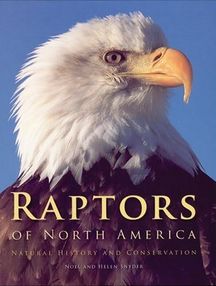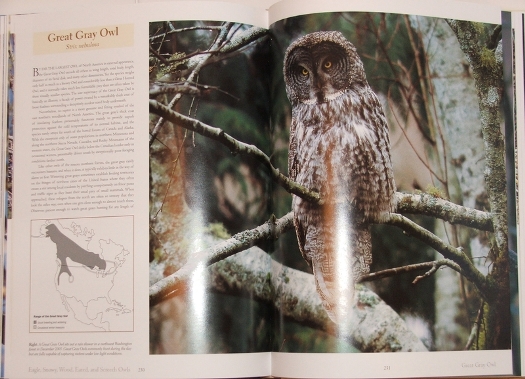Reviewed by Grant McCreary on September 29th, 2007.
As a group, diurnal and nocturnal raptors seem to be overrepresented in published works. I’m really not surprised, though, as these birds evoke a sense of awe and wonder that few others do. Just think of some of the adjectives used to describe them: majestic; regal; fierce; powerful. But at some point is enough enough? Do we really need another book about birds of prey? Such were my thoughts when this book was released. But I am happy to say that the publication of this book was fully justified.
The book starts with a few short introductory sections that gives the purpose of the book, describes the different groups of raptors, and teaches how to observe and study raptors.
The remainder of the book consists of 53 species accounts, broken down as follows: vultures – 3; kites – 5; harriers – 1; hawks – 15; eagles/osprey – 3; falcons – 7; owls – 19. As the title suggests, the focus of the accounts is on the natural history and conservation of the particular species. All the basics of the raptor’s biology are covered, with special emphasis on nesting and breeding. Conservation is not covered as extensively as the natural history. The basics are included, though, including threats and population estimates and trends. The accounts average 4-5 pages in length, with the shortest one being 3 pages and the longest 12.
In many books similar to this one the details of the bird’s life are recounted in an impersonal and objective manner. There is certainly a need for that, but it has already been done in works such as The Birds of North America project. So it was a relief to find that the authors did not go that route in this book. The accounts are based mostly on stories and personal experience from performing research on these birds. They are able to successfully infuse this familiarity into the text, helping the reader to really get to know these birds at a level that most other books do not attain. For instance, they talk extensively about the Elf Owls that nest in the backyard of their Arizona home. In the process they reveal all the expected information such as clutch size, incubation time, and the fledging process. But these experiences also serve to demonstrate what these birds are like in real life apart from just the general facts.
As good as the text is the book would not be complete without illustrations. In this case some really excellent photography by the authors. There are multiple photographs of each species, in addition to shots of habitat, prey, and nests. The quality range from ok to spectacular, with most tending toward the latter. This is a large book, and thankfully many stunning full-page photos take full advantage of all the room.
Finally, each account includes a range map showing breeding, winter, and permanent ranges. The map covers Canada, the United States, Mexico, and most of Central America and the Caribbean. Unfortunately, the only political boundaries shown are those between the US and Canada and Mexico.
Recommendation
This book is not recommended for those who just want basic natural history information or those only interested in how to identify these birds. (Though I must note that there are a few ID hints and, of course, all those wonderful photos could come in handy). It is, however, highly recommended to all who would like to better know and understand the raptors of North America.
Disclosure: I get a small commission for purchases made through links in this post.






Thanks for that information and facts. It’s very much appreciated! Thanks again.